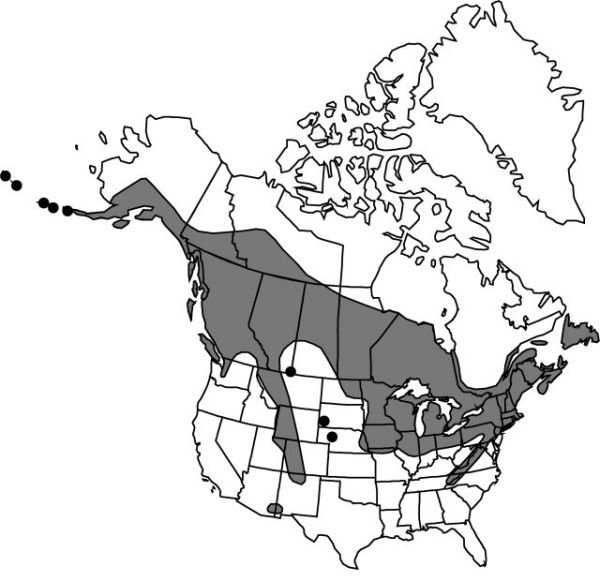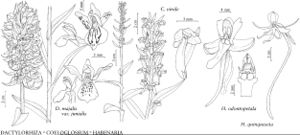Coeloglossum viride
Handb. Skand. Fl., 329. 1820.
Plants 6–80 cm. Leaves 2–several; proximal blades obovate to oblanceolate, the distal oblong-lanceolate, becoming reduced to bracts, 2–18 × 1–7 cm. Inflorescences: floral bracts usually widely spreading, sometimes ascending (especially northward), conspicuous. Flowers greenish, often suffused with dull red or brown; sepals ovate, 3–8 × 2–5 mm, forming hood over column; petals linear, 3–5 × 0.5 mm; lip descending beneath hood, 3–10 × 0.5–4 mm; spur inconspicuous. Capsules 7–14 × 4–5 mm. 2n = 40.
Phenology: Flowering late spring–summer.
Habitat: Moist to wet coniferous and hardwood forests, tundra, prairies, meadows, thickets, coastal heaths, and bogs
Elevation: 0–2800 m
Distribution

Alta., B.C., Man., N.B., Nfld. and Labr. (Nfld.), N.W.T., N.S., Ont., P.E.I., Que., Sask., Yukon, Alaska, Ariz., Colo., Conn., Ill., Ind., Iowa, Maine, Md., Mass., Mich., Minn., Mo., Mont., Nebr., N.H., N.J., N.Mex., N.Y., N.C., N.Dak., Ohio, Pa., R.I., S.Dak., Tenn., Utah, Vt., Va., Wash., W.Va., Wis., Wyo., Eurasia
Discussion
Recent molecular studies, in which nuclear ribosomal DNA internal transcribed spacer (ITS) sequences were analyzed, showed that within the palmate-tuber clade Coeloglossum is embedded within a strongly supported, monophyletic Dactylorhiza (A. M. Pridgeon et al. 1997); subsequently the monotypic Coeloglossum was formally transferred to Dactylorhiza (R. M. Bateman et al. 1997). The latter authors note that although Coeloglossum differs from Dactylorhiza in many morphologic characters, relatively little molecular divergence has occurred. In this treatment we continue to recognize them as separate but closely related genera.
Coeloglossum viride is quite variable across its range, and most American plants are referable to Coeloglossum viride (Linnaeus) Hartman var. virescens (Muhlenberg) Luer. These plants have been distinguished from the largely Eurasian subsp. viride by very long, spreading floral bracts greatly exceeding the flowers. The often large, stout plants with prominently bracted inflorescences and obscure flowers with mostly greenish lips are indeed distinctive. Similar plants also occur in Europe and eastern Asia, however. Small plants referable to subsp. viride, with reduced bracts and few-flowered inflorescences, often with wholly reddish lips, occur in Alaska, where nonetheless most plants are typical of the widespread American plant. Supposedly intermediate plants from the northern part of the American range of the species were described as Habenaria viridis (Linnaeus) R. Brown var. interjecta Fernald. At least in part these differ from long-bracted American plants merely in the long bracts being more nearly appressed to the rachis rather than wide-speading. Very likely the variation in this species should be recognized at some level, but the focus on a single character and its variable expression on different continents does not provide an adequate basis for taxonomy.
Selected References
None.
Lower Taxa
"elongated" is not a number.
